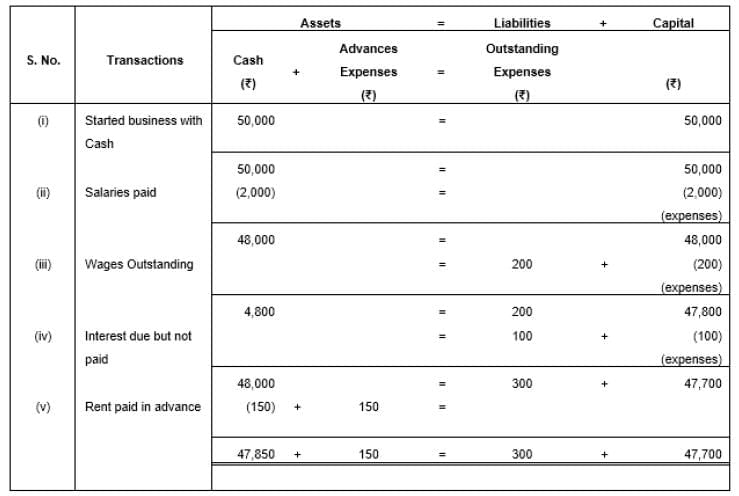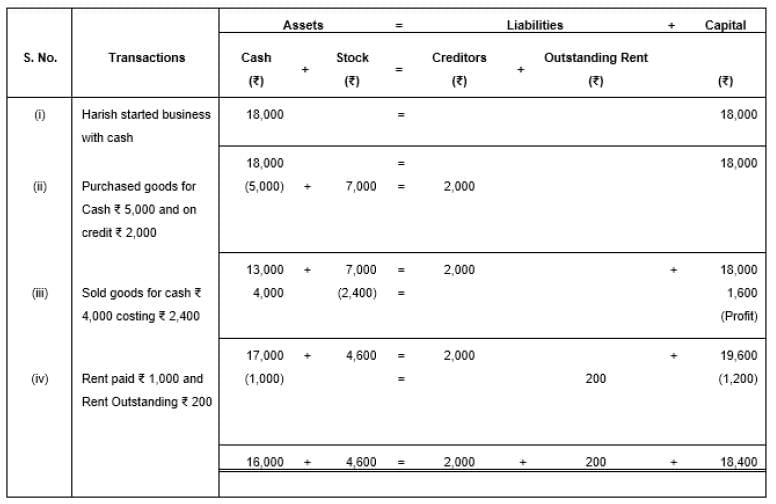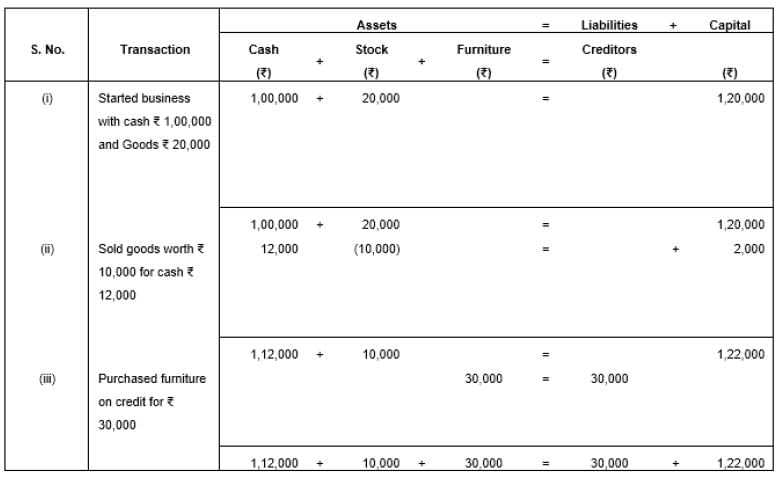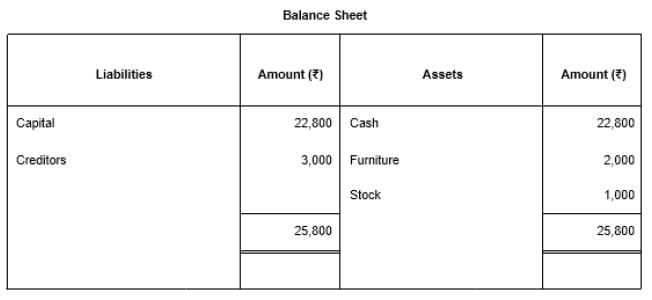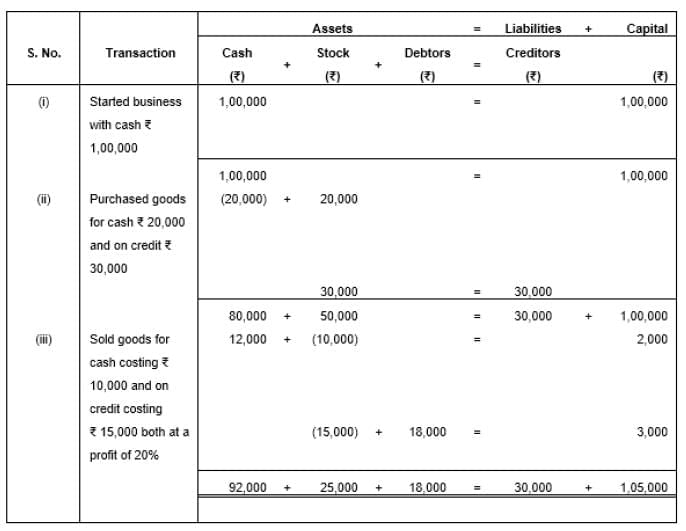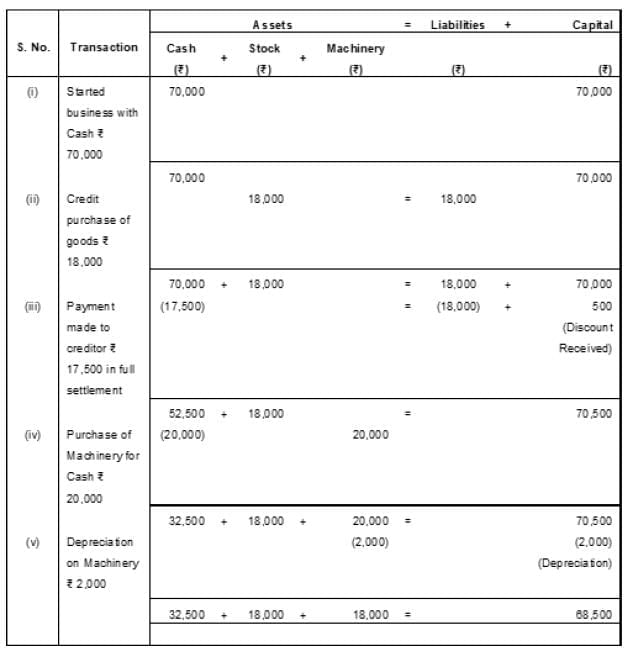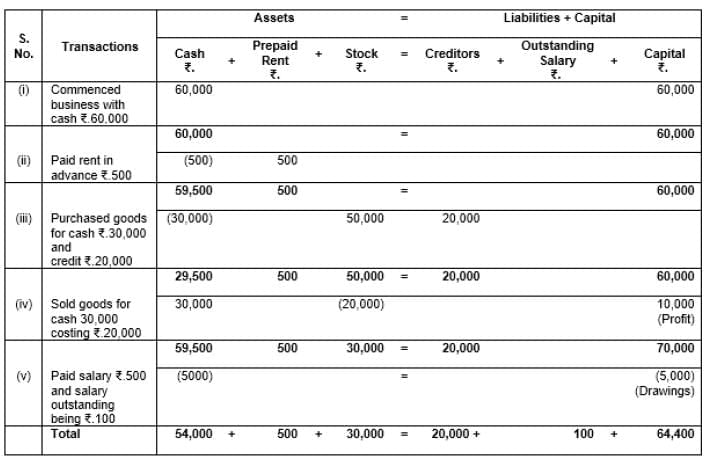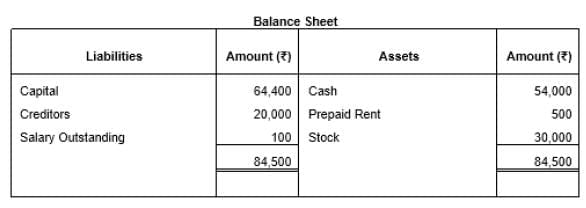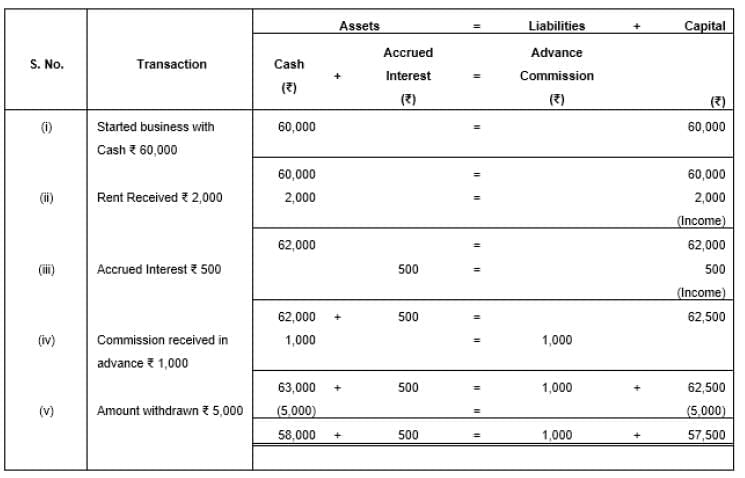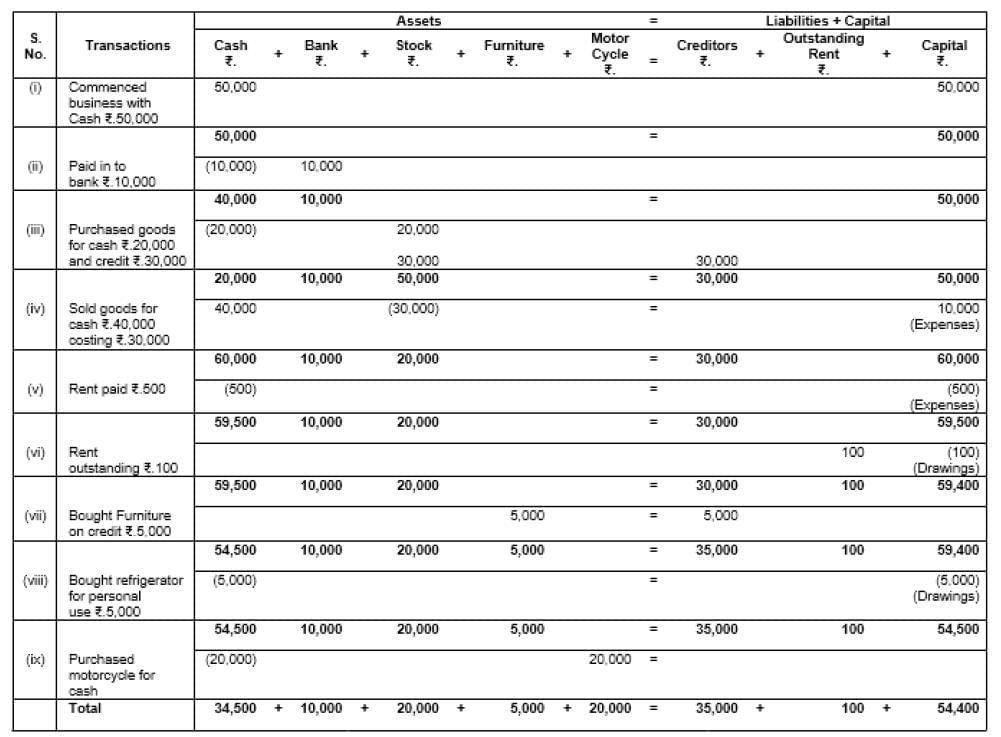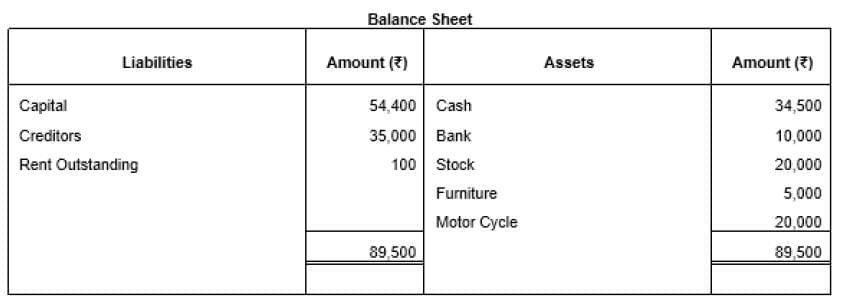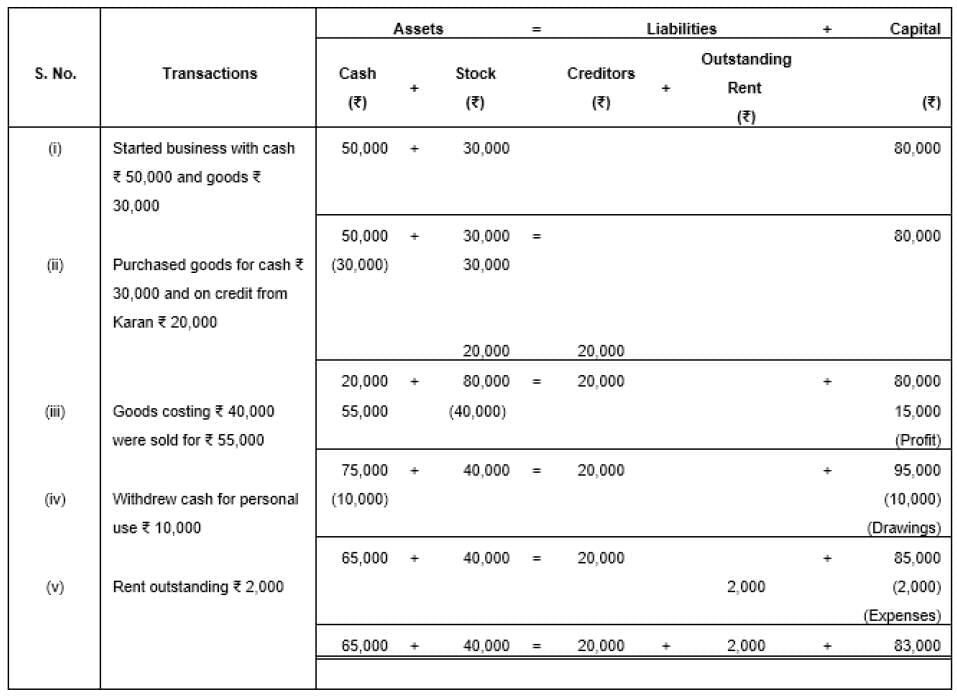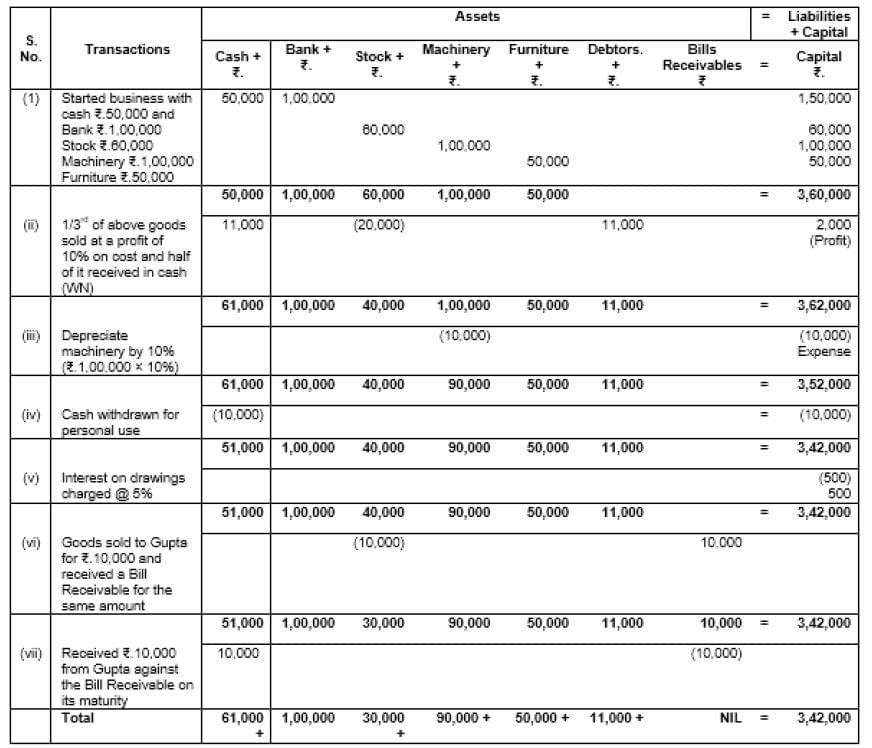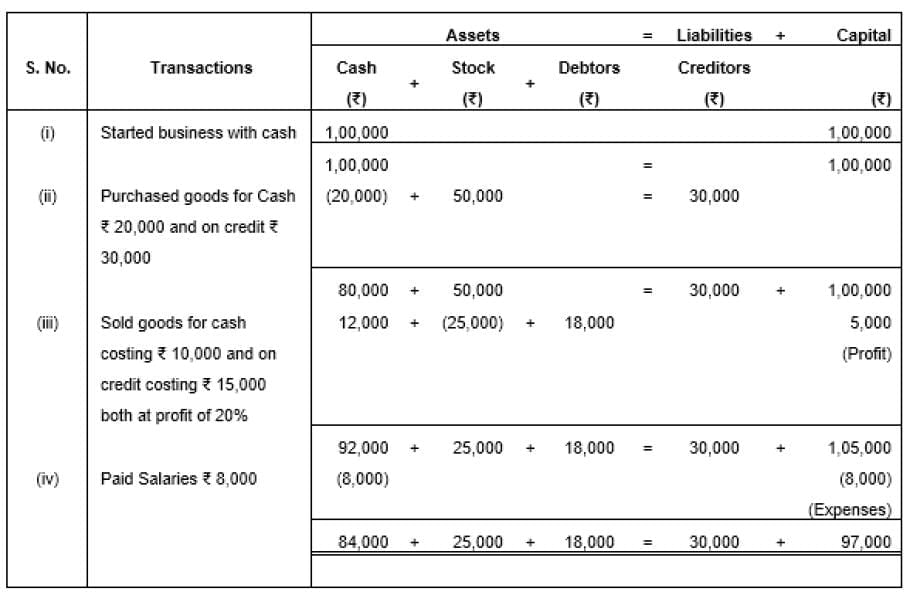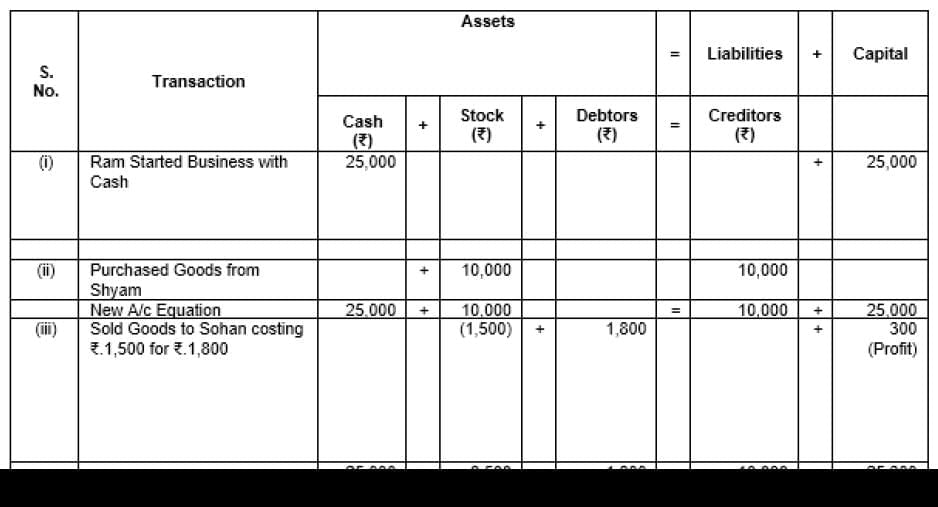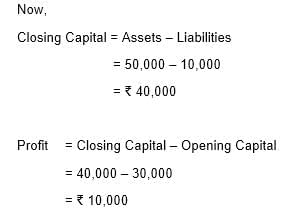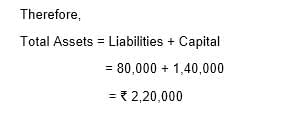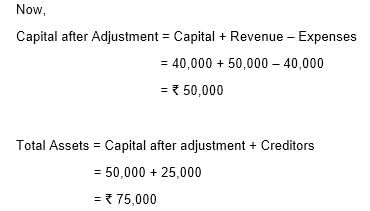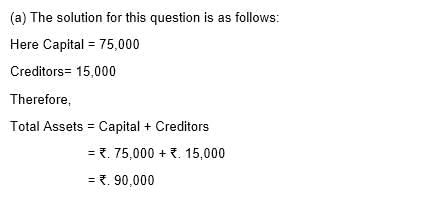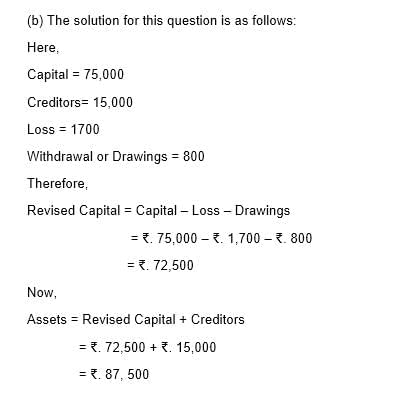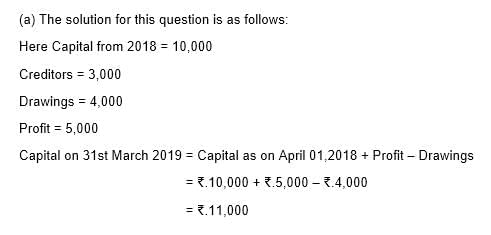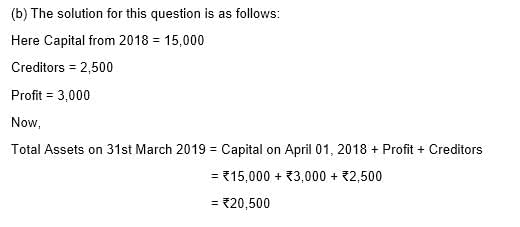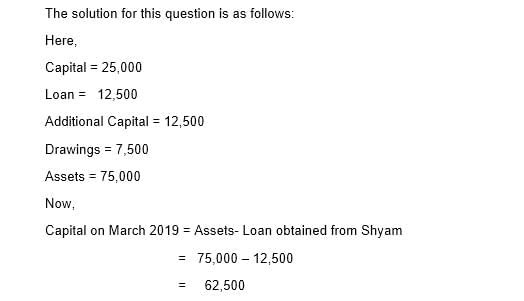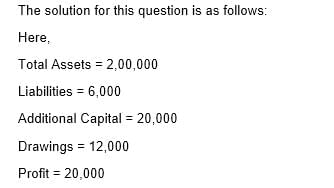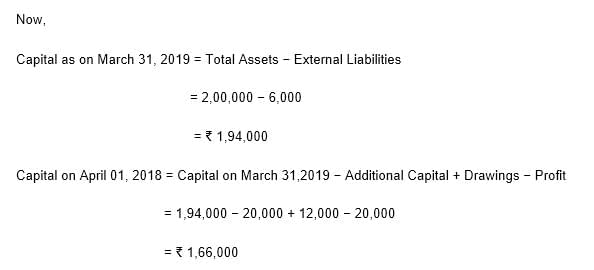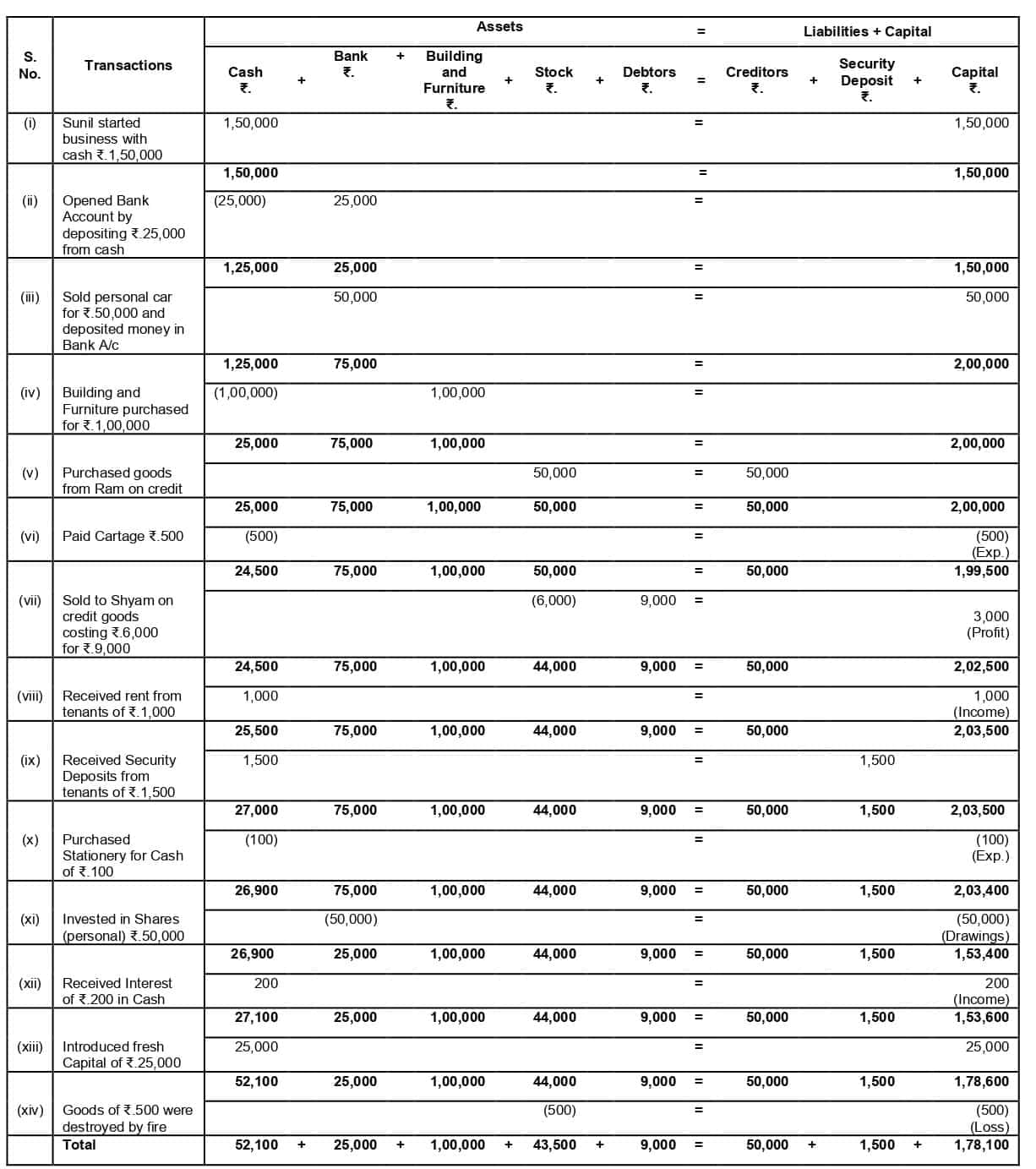Accounting Equation | Accountancy Class 11 - Commerce PDF Download
Q1: What will be effect of the following on the Accounting Equation?
(i) Started business with cash ₹ 45,000
(ii) Opened a Bank Account with a deposit of ₹ 4,500
(iii) Bought goods from M\s. Sun & Co. for ₹ 11,200
Ans: This question is as follows:
Therefore, Liabilities = 11,200
Capital = 45,000
Assets = Liabilities + Capital
= 45,000 + 11,200 = 56,200
Q2: Show the Accounting Equation for the following transactions:
Ans: This question is as follows:
Here, Liabilities = 10,000
Capital = 19,700
Assets = 10,000 + 19,700 = 29,700
Q3: Show the effect of the following transactions on the Accounting Equation:
(i) Started business with cash ₹ 50,000.
(ii) Salaries paid ₹ 2,000.
(iii) Wages Outstanding ₹ 200.
(iv) Interest due but not paid ₹ 100.
(v) Rent paid in advance ₹ 150.
Ans: This question is as follows:
Q4: What will be the effect of the following on the Accounting Equation?
(i) Harish started business with cash ₹ 18,000
(ii) Purchased goods for Cash ₹ 5,000 and on credit ₹ 2,000
(iii) Sold goods for cash ₹ 4,000 (costing ₹ 2,400)
(iv) Rent paid ₹ 1,000 and rent outstanding ₹ 200
Ans: This question is as follows:
Q5: Prepare Accounting Equation from the following:
(i) Started business with cash ₹ 1,00,000 and Goods ₹ 20,000.
(ii) Sold goods worth ₹ 10,000 for cash ₹ 12,000.
(iii) Purchased furniture on credit for ₹ 30,000.
Ans: This question is as follows:
Q6: Prepare an Accounting Equation and Balance Sheet on the following basis:
(i) Ajeet started business with cash ₹ 20,000.
(ii) He purchased furniture for ₹ 2,000.
(iii) He paid rent of ₹ 200.
(iv) He purchases goods on credit ₹ 3,000.
(v) He sold goods (cost price ₹ 2,000) for ₹ 5,000 on cash.
Ans: This question is as follows:
The balance sheet is prepared as follows
Q7: Prepare an Accounting Equation from the following:
(i) Started business with cash ₹ 1,00,000.
(ii) Purchased goods for cash ₹ 20,000 and on credit ₹ 30,000.
(iii) Sold goods for cash costing ₹ 10,000 and on credit costing ₹ 15,000 both at a profit of 20%.
Ans: This question is as follows:
Q8: Prepare an Accounting Equation on the basis of the following transactions:
(i) Started business with cash ₹ 70,000.
(ii) Credit purchase of goods ₹ 18,000.
(iii) Payment made to creditors in full settlement ₹ 17,500.
(iv) Purchase of machinery for cash ₹ 20,000.
(v) Depreciation on machinery ₹ 2,000.
Ans: This question is as follows:
Q9: Prove that the Accounting Equation is satisfied in all the following transactions of Suresh. Also prepare a Balance Sheet.
(i) Commenced business with cash ₹ 60,000.
(ii) Paid rent in advance ₹ 500.
(iii) Purchased goods for cash ₹ 30,000 and credit ₹ 20,000.
(iv) Sold goods for cash ₹ 30,000 costing ₹ 20,000.
(v) Paid salary ₹ 500 and salary outstanding being ₹ 100.
(vi) Bought motorcycle for personal use ₹ 5,000.
Ans: This question is as follows:
Here, Liabilities = 20,000 + 100 = 20,100
Capital = 64,400
Assets = 64,400 + 20,100 = 84,500Balance sheet is prepared as follows
Q10: Show the effect of the following transactions and also prepare a Balance Sheet:
(i) Started business with cash ₹ 60,000.
(ii) Rent received ₹ 2,000.
(iii) Accrued interest ₹ 500.
(iv) Commission received in advance ₹ 1,000.
(v) Amount withdrawn ₹ 5,000.
Ans: This question is as follows:
Balance sheet is prepared as follows
Q11: Prove that the Accounting Equation is satisfied in all the following transactions of Sameer Goel:
(i) Started business with cash ₹ 10,000.
(ii) Paid rent in advance ₹ 300.
(iii) Purchased goods for cash ₹ 5,000 and credit ₹ 2,000.
(iv) Sold goods for cash ₹ 8,000 costing ₹ 4,000.
(v) Paid salary ₹ 450 and salary outstanding being ₹ 100.
(vi) Bought motorcycle for personal use ₹ 3,000.
Ans: This question is as follows:
Here, Liabilities = 2000 + 100 = 2100
Capital = 10,450
Assets = 10,450 + 2100 = 12,550
Q12: Show the Accounting Equation on the basis of the following transactions and present a Balance Sheet on the last new equation balance: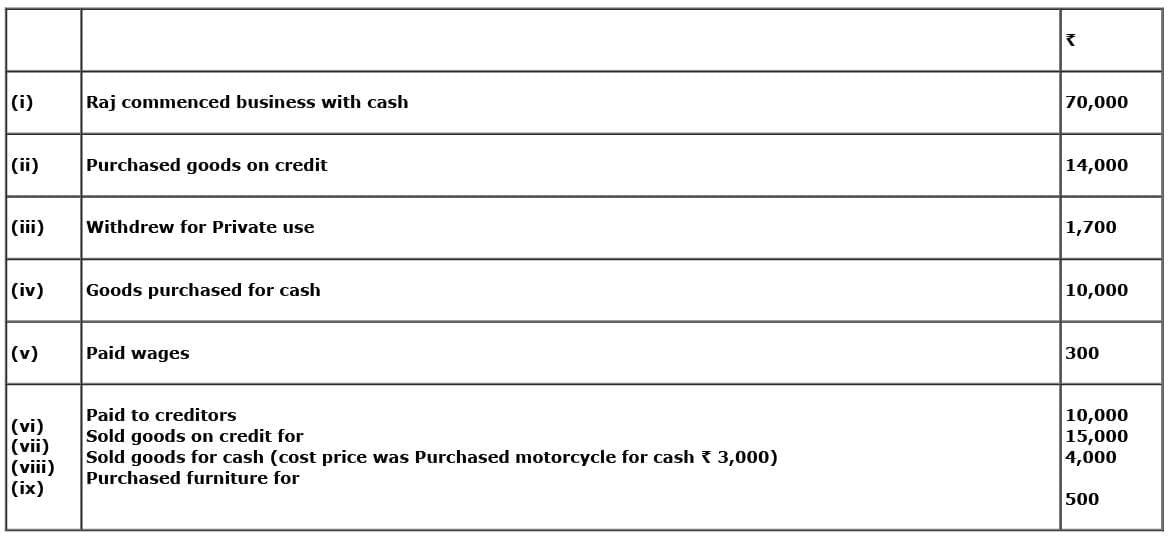
Ans: This question is as follows:
Balance sheet is prepared as follows
Q13: Raghunath had the following transactions in an accounting year:
(i) Commenced business with cash ₹ 50,000.
(ii) Paid into bank ₹ 10,000.
(iii) Purchased goods for cash ₹ 20,000 and credit ₹ 30,000.
(iv) Sold goods for cash ₹ 40,000 costing ₹ 30,000.
(v) Rent paid ₹ 500. (vi) Rent outstanding ₹ 100.
(vii) Bought furniture ₹ 5,000 on credit.
(viii) Bought refrigerator for personal use ₹ 5,000.
(ix) Purchased motorcycle for cash ₹ 20,000.
Create an Accounting Equation to show the effect of the above and also show his Balance Sheet.
Ans: This question is as follows:
Balance sheet is prepared as follows
Q14: Prepare an Accounting Equation from the following:
(i) Started business with cash ₹ 50,000 and goods ₹ 30,000.
(ii) Purchased goods for cash ₹ 30,000 and on credit from Karan ₹ 20,000.
(iii) Goods costing ₹ 40,000 were sold for ₹ 55,000.
(iv) Withdrew cash for personal use ₹ 10,000.
(v) Rent outstanding ₹ 2,000.
Ans: This question is as follows:
Q15: Show an Accounting Equation for the following transactions:
(i) D. Mahapatra commenced business with cash ₹ 50,000 and ₹ 1,00,000 by cheque; goods ₹ 60,000; machinery ₹ 1,00,000 and furniture ₹ 50,000.
(ii) 1/3rd of above goods sold at a profit of 10% on cost and half of the payment is received in cash.
(iii) Depreciation on machinery provided @ 10%.
(iv) Cash withdrawn for personal use ₹ 10,000.
(v) Interest on drawings charged @ 5%.
(vi) Goods Sold to Gupta for ₹ 10,000 and received a Bill Receivable for the same amount for 3 months.
(vii) Received ₹ 10,000 from Gupta against the Bills Receivable on its maturity.
Ans: This question is as follows:
Q16: Prepare Accounting Equation from the following:
(a) Started business with cash ₹ 1,00,000.
(b) Purchased goods for cash ₹ 20,000 and on credit ₹ 30,000.
(c) Sold goods for cash costing ₹ 10,000 and on credit costing ₹ 15,000 both at a profit of 20%.
(d) Paid salaries ₹ 8,000.
Ans: This question is as follows:
Q17: Show the accounting equation on the basis of following transactions:
(a) Ram started business with ₹ 25,000.
(b) Purchased goods from Shyam ₹ 10,000.
(c) Sold goods to Sohan costing ₹ 1,500 for ₹ 1,800.
Ans: This question is as follows:
Q18: If the capital of a business is ₹ 3,00,000 and liabilities are ₹ 50,000, loss ₹ 70,000, calculate the total assets of the business.
Ans: We know that total assets of a business can be calculated by
Total Assets = Capital - Loss + Liabilities
= 3,00,000 - 70,000 + 50,000
= ₹ 2,80,000
Q19: If total assets of a business are ₹ 1,30,000 and net worth is ₹ 80,000, calculate the creditors.
Ans: The value of creditors can be calculated as follows
Creditors = Total Assets - Net worth
= 1,30,000 - 80,000
= 50,000
Q20: A commenced his cloth business on 1st April, 2018 with a capital of ₹ 30,000. On 31st March 2019, his assets were worth ₹ 50,000 and liabilities of ₹ 10,000. Find out his closing capital and profits earned during the year.
Ans: Here Capital = 30,000
Assets = 50,000
Liabilities = 10,000
Q21: If capital of a business is ₹ 1,40,000 and liabilities are of ₹ 80,000, calculate the total assets of the business.
Ans: Here Capital = 1,40,000
Liabilities = 80,000
Q22: Calculate the total assets if:
(i) Capital is ₹ 40,000.
(ii) Creditors are ₹ 25,000.
(iii) Revenue during the period is ₹ 50,000.
(iv) Expenses during the period are ₹ 40,000.
Ans: Here Capital = 40,000
Creditors = 25,000
Revenue = 50,000
Expenses = 40,000
Q23: (a) A had a capital of ₹ 75,000 on 1st April, 2018. He had also goods amounting to ₹ 15,000 which he had purchased on credit and the payment had not been made. Find out the value of the total assets of the business.
(b) After a period of one month, he came to know that he had suffered a loss of ₹ 1,700. He withdrew ₹ 800 for his personal use. Find out his capital and assets of the business.
Ans:
Q24: (a) Mohan started a business on 1st April, 2018 with a capital of ₹ 10,000 and borrowed ₹ 3,000 from a friend. He earned a profit of ₹ 5,000 during the year ended 31st March, 2019 and withdrew cash ₹ 4,000 for personal use. What is his capital on 31st March, 2019?
(b) Mahesh started a business with a capital of ₹ 15,000 on 1st April, 2018. During the year, he made a profit of ₹ 3,000. He owes ₹ 2,500 to suppliers of goods. What is the total of assets in his business on 31st March, 2019?
Ans:
Q25: Mohan started a business on 1st April, 2018 with a capital of ₹ 25,000 and a loan of ₹ 12,500 borrowed from Shyam. During 2018-19 he had introduced additional capital of ₹ 12,500 and had withdrawn ₹ 7,500 for personal use. On 31st March, 2019 his assets were ₹ 75,000. Find out his capital as on 31st March, 2019 and profit made or loss incurred during the year 2018-19.
Ans:
Q26: On 31st March, 2019, the total assets and external liabilities were ₹ 2,00,000 and ₹ 6,000 respectively. During the year, the proprietor had introduced capital of ₹ 20,000 and withdrawn ₹ 12,000 for personal use. He made a profit of ₹ 20,000 during the year. Calculate the capital as on 1st April, 2018.
Ans:
Q27: Show an Accounting Equation on the basis of the following transactions: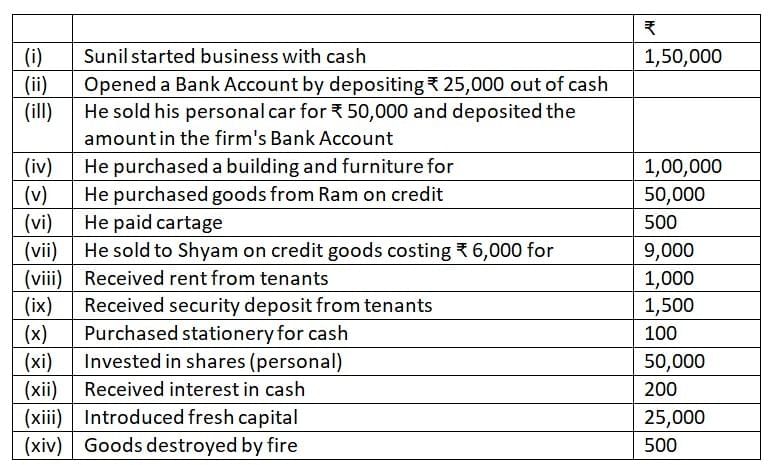
Ans: This question is as follows:
|
61 videos|154 docs|35 tests
|
FAQs on Accounting Equation - Accountancy Class 11 - Commerce
| 1. What is the accounting equation and how is it fundamental to financial accounting? |  |
| 2. How does the accounting equation apply to different types of businesses? |  |
| 3. What are the implications of the accounting equation for financial reporting? |  |
| 4. Can the accounting equation help in identifying financial problems within a company? |  |
| 5. How can understanding the accounting equation benefit individuals studying commerce? |  |

